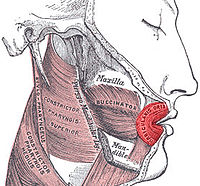
Photo from wikipedia
Previous research has indicated that differences in sensitivities to muscle relaxants exist between facial nerve- and somatic nerve-innervated muscles. Here, we report that the 50% inhibitory concentration (IC50) values for… Click to show full abstract
Previous research has indicated that differences in sensitivities to muscle relaxants exist between facial nerve- and somatic nerve-innervated muscles. Here, we report that the 50% inhibitory concentration (IC50) values for rocuronium were significantly larger in the normal orbicularis oris than those in the gastrocnemius. Increased IC50 values and reduced twitch tension were observed after facial nerve injury. The normal orbicularis oris had a smaller muscle fiber cross-sectional area (CSA) and a larger ratio of endplate surface area (ESA) to muscle fiber CSA (ESA/CSA), but no difference was found in the density of nicotinic acetylcholine receptor (nAChR) subunits on endplates between normal orbicularis oris and gastrocnemius. Expression of the nAChR α1, β1, δ, ε, and γ subunits increased significantly on the postsynaptic membranes of endplates and extra-junctional muscle membranes after facial nerve injury. Our results suggest that facial nerve-innervated muscle was less sensitive than somatic nerve-innervated muscle, and the mechanisms underlying this result may be related to muscle fiber CSA and the ESA/CSA ratio, but not to the density of nAChR subunits on endplates. Facial nerve injury caused the resistance to neuromuscular blockers and reduced twitch tension, which was related to qualitative, quantitative, and locational changes in nAChR subunits.
Journal Title: Scientific Reports
Year Published: 2017
Link to full text (if available)
Share on Social Media: Sign Up to like & get
recommendations!